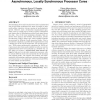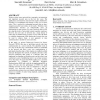152 search results - page 9 / 31 » Using Simple Diffusion to Synchronize the Clocks in a Distri... |
CL
2010
Springer
13 years 7 months ago
2010
Springer
In this paper we present the syntax, semantics, and compilation of a new system-level programming language called SystemJ. SystemJ is a multiclock language supporting the Globally...
ICASSP
2009
IEEE
14 years 2 months ago
2009
IEEE
Distributed synchronization is known to occur at several scales in the brain, and has been suggested as playing a key functional role in perceptual grouping. State-of-the-art visu...
ISLPED
2003
ACM
14 years 24 days ago
2003
ACM
Ever shrinking device sizes and innovative micro-architectural and circuit design techniques have made it possible to have multi-million transistor systems running at multi-gigahe...
SENSYS
2003
ACM
14 years 24 days ago
2003
ACM
Wireless ad-hoc sensor networks have emerged as an interesting and important research area in the last few years. The applications envisioned for such networks require collaborati...
SENSYS
2004
ACM
14 years 29 days ago
2004
ACM
Wireless sensor network applications, similarly to other distributed systems, often require a scalable time synchronization service enabling data consistency and coordination. Thi...



